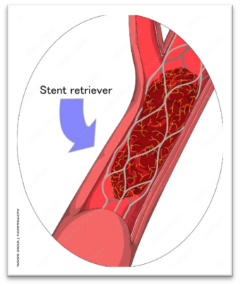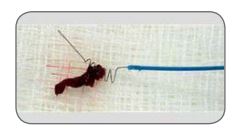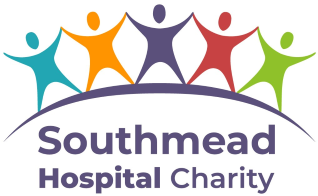Information for friends and relatives about mechanical clot retrieval for ischaemic stroke at North Bristol NHS Trust.
What has happened?
Your friend or relative has had an ischaemic stroke and needs an emergency procedure.
Strokes happen when an artery (blood vessel) is blocked by a clot, cutting off blood flow to part of the brain. Without a blood supply, brain cells can be damaged or destroyed because they may not receive enough oxygen.
Symptoms may have included numbness or weakness on one side of the body, problems with balance, speech, vision, and/ or swallowing.
What is thrombolysis?
Thrombolysis is a drug treatment which is given within 4 hours of an ischaemic stroke to dissolve the blood clot.
It is a treatment that is not suitable for everyone and is less effective than mechanical thrombectomy when the clot is large. Certain medications or medical conditions may mean that thrombolysis is not the suitable for all patients.
What is mechanical clot retrieval?
- Mechanical clot retrieval aims to remove the blood clot from the affected artery in the brain, restoring blood flow and minimising brain tissue damage.
- The procedure is often done using general anaesthesia (patient will be asleep).
- A thin tube called a catheter is inserted into an artery, usually in the groin, and moved towards the site of the clot. The clot retrieval device is inserted through the catheter.
- Different devices and methods are used to remove blood clots. The most commonly used device is called a stent retriever, which traps and removes the clot.
- The aim is to remove the clot as soon as possible, within a few hours of the stroke to restore blood flow to the affected area of the brain.
The procedure is only suitable for some patients, a healthcare team experienced in managing acute ischaemic stroke will decide if you are suitable for this procedure. The following will factors will be taken into consideration:
- The vessel the blood clot is in.
- The time the stroke happened.
- Other medical conditions.
- The patients ability to care for themselves.
Stent retrieval of a clot

Clot that has been removed

Who will do the procedure?
An experienced Consultant Neuro Interventional Radiologist and their team will perform the procedure in the radiology department.
The Interventional Radiology nurses and the Stroke Nurse Practitioner will keep in close contact and keep you updated after the procedure.
External transfers to Southmead Hospital
Patients who have been transferred to Southmead Hospital will be reassessed when they arrive, and they may also need further CT scans.
Please be aware that patients may no longer be suitable for treatment once they arrive, if further damage to brain tissue has happened.
Occasionally after thrombolysis the clot may have dissolved, or moved to an artery further away that is not suitable for a thrombectomy. In this case the patient will be transferred back to their local hospital for ongoing care and investigations.
In some cases, patients may have had worsening of their stroke symptoms, and the area of damage (ischaemia) has become larger. In these cases, the procedure is unlikely to be helpful.
Patients may need to stay at Southmead for observation if they are unwell or may transfer directly back to their local stroke centre or hospital.
What are the benefits of mechanical clot retrieval?
The procedure has been shown to significantly improve chances of surviving and preserving quality of life, if done within the first twelve hours of symptoms starting. This will be alongside other specialist medical treatment and care.
The aim is to prevent stroke symptoms getting worse, but does not reverse the damage that has already occurred to the brain.
The procedure can be done up to 24 hours after a stroke, depending on the level of damage in the brain. Every patient is different, and some patients may experience irreversible damage to the brain quicker than others.
What are the risks of mechanical clot retrieval?
The brain is fragile following a stroke, and there is risk of causing bleeding by puncturing a vessel during the procedure. This can cause severe disability or death.
There is also a risk of groin site bleeding, abdominal internal bleeding, or disrupted blood supply to the lower limbs which may need further surgery.
There is a small risk of infection at the groin site.
What happens after the procedure?
- After the procedure, patients go to the recovery unit where staff closely monitor blood pressure and groin site.
- Occasionally patients may need to go to the intensive care unit if specialist blood pressure treatment is required for a short time.
- Otherwise, patients will go to the hyperacute stroke ward (Ward 34B).
- Patients will have close monitoring and observations, which will include heart monitoring, frequent measurements of blood pressure, heart rate, and oxygen saturation levels.
- Staff will test the strength in arms/legs, speech, and level of consciousness.
- Any signs of neurological deterioration will be detected quickly and patient will have further CT scans as necessary.
- Patients will usually stay in this area for 48-72 hours before being moved to the acute stroke unit area of the ward.
What happens after the procedure?
- If your friend or relative came from another hospital then they will stay with us until they are stable to return to their local hospital. This is normally 24-48 hours.
- It will depend on the type and severity of your stroke.
- It will depend how well they are recovering and whether they need rehabilitation.
Strokes affect everyone differently and recovery from depends on many factors:
- Where the stroke occurred in the brain.
- The severity of the stroke.
- The age of the patient and their medical history.
If you have any questions about the procedure or care following the procedure, do not hesitate to speak to any of our stroke team. This leaflet is only a starting point for discussion and our doctors and nurses can answer any of your queries during your friend or relatives stay.
You can contact the Hyperacute Stroke Unit on: 0117 414 3600.
References and further information
The Stroke Association
0303 303 3100
Stroke Association / Finding strength through support
Stroke association information about thrombectomy
What is Thrombectomy? | Stroke Association
Bristol Area Stroke Foundation
0117 964 7657
© North Bristol NHS Trust. This edition published July 2024. Review due July 2027. NBT003017.
Support your local hospital charity

See the impact we make across our hospitals and how you can be a part of it.

